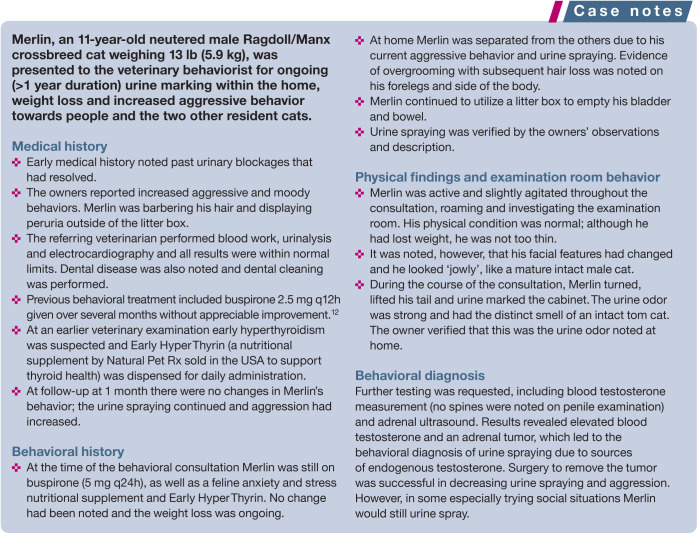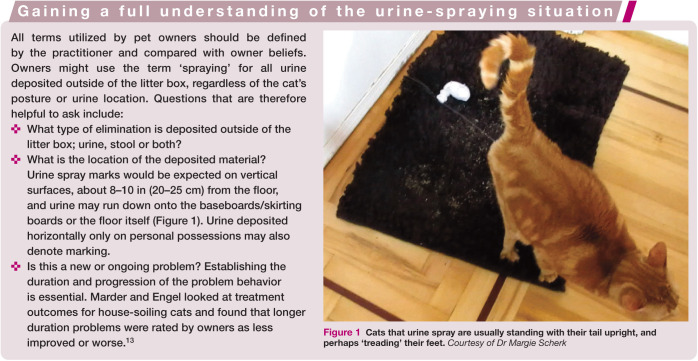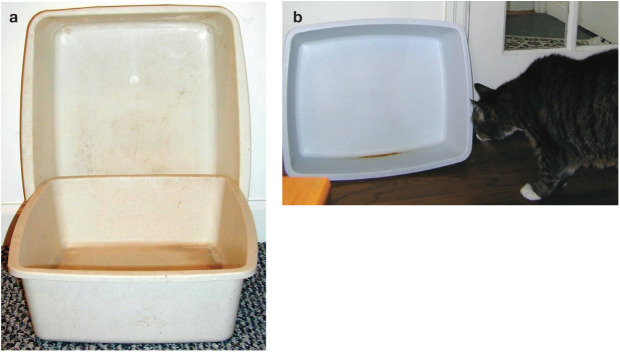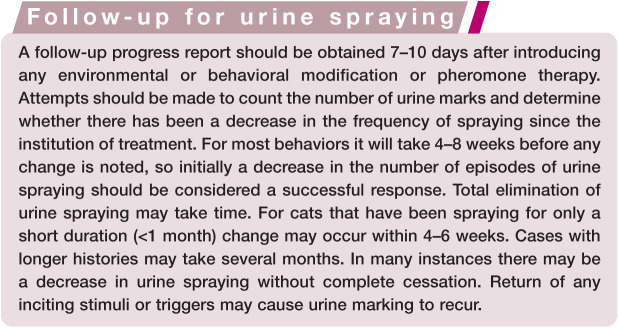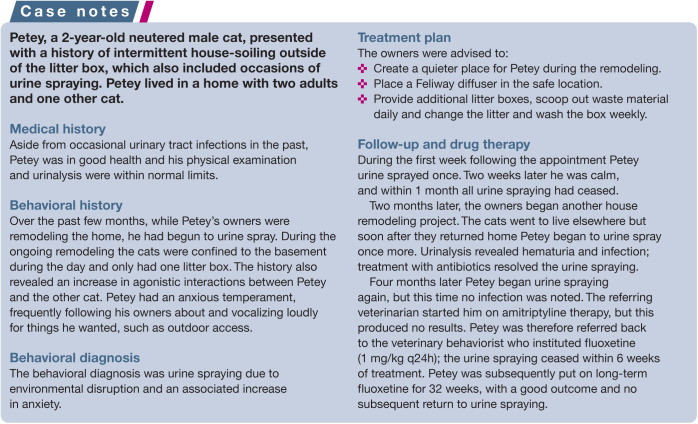Abstract
Practical relevance:
Urine spraying (synonymous terms include urine marking or scent marking) is commonly described as urine deposited on vertical surfaces while the cat is in a standing position. With the increasing trend of keeping cats indoors in some countries and the potential resultant increase in frustration-related behaviors, urine spraying may occur in the home. Although also a normal feline behavior, it is usually not deemed acceptable when the cat targets household possessions. Urine spraying is a common behavioral complaint that practitioners receive from cat owners and has the potential to disrupt the human–cat bond. In fact, feline elimination issues are a frequent reason cited by owners when they relinquish their cats to shelters and rescue organizations.
Clinical challenges:
While the location of the deposited urine should be diagnostic, this is not always the case. Urine marking can occur on horizontal surfaces, thus complicating the diagnosis. Urine spraying by intact males and females is used to signal availability for mating but the behaviour can also be exhibited by neutered animals. Multiple factors including medical problems can trigger the onset and maintenance of urine spraying, and correct identification of these is necessary for treatment to be most successful.
Evidence base:
This review draws on information from multiple studies that have been published on the normal aspects of urine spraying in cats, the frequency as reported by owners, the relationship of urine spraying to intercat aggression and various treatment options including behavior modification, pheromone therapy and use of psychoactive medication.
Keywords: Urine spraying, vertical deposition, normal behavior, intercat aggression
Communication and the function of urine spraying
Cats use a range of modalities (ie, body postures, facial expressions, tactile stimuli or touch, and grooming and scratching with claws) as means of communicating information, as discussed elsewhere in this feline behaviour special issue series. Urine spraying is a form of communication that utilizes olfactory and visual cues to transmit information. Communication in domestic species is often predicated on that of their wild counterpart. The most likely ancestor of the domestic cat is the African/Arabian wildcat, which is territorial and often solitary. The use of scent marks thus allows communication without face-to-face encounters. Scent marks can remain in the environment for some time, though are subject to the vagaries of the weather and also the behavior of any other individuals encountering the mark (ie, whether they spray over the existing scent mark).
It is generally recognized that urine marking is a normal felid behavior. It is utilized by intact males and females to advertise availability for mating. Beyond that it is not clear how urine marking functions cat-to-cat other than that it involves a volatile substance, and intact male urine in particular is pungent and usually offensive to the human nose.
Felids deposit urine either by squatting or standing and both male and female cats can spray urine on vertical surfaces. Urine marks within the home are often found in socially significant places such as on owner possessions or laundry, or in prominent locations. Cats that mark with urine on vertical surfaces usually continue to use the litter box for elimination of both urine and stool. Although often considered to be a behavior of intact animals, neutered animals will urine spray and cats will often mark inside the house as a territorial response to the presence of outside cats.
It is not totally clear what message is sent by the spraying cat and what is received by cats that encounter the scent. Cats will investigate the urine of other cats deposited on horizontal surfaces and the duration of sniffing increases when the urine is from an unfamiliar cat. Natoli’s research found that vertical spray marks of unfamiliar tom cats were investigated for longer than those of familiar cats, and also longer than horizontal surface eliminations from unfamiliar toms. 1 Spray marks from estrous females initiate a flehman response in males and likely carry some information that is salient to the cat. However, the territorial function of urine spraying is unclear.
A study by Pryor et al on urine-spraying cats found that male cats and cats from multi-cat households were significantly over-represented in the study sample. 2 When owners were asked about potential causal factors, the most commonly cited ones were agonistic interactions with other cats inside or outside the home. 2
Prevalence of urine spraying in owned cats
It is well accepted that intact male and female cats routinely urine spray. However, in the USA and many European countries cats are commonly neutered (see box below). The prevalence of urine spraying in household cats is variously determined based on owner reports to clinicians or to shelter/rescue personnel upon animal relinquishment, and in retrospective studies.
Bamberger and Houpt’s retrospective study reviewed 736 cats presented to the Animal Behavior Clinic at Cornell University over a 10 year period (1991–2001). 6 Examined records varied in how behaviors were classified but these investigators recorded 128 cats presented for marking behavior and 128 cats for spraying; it is unclear if these are different groups of cats or concomitant diagnoses for an individual cat. Male cats accounted for 75% of the cases.
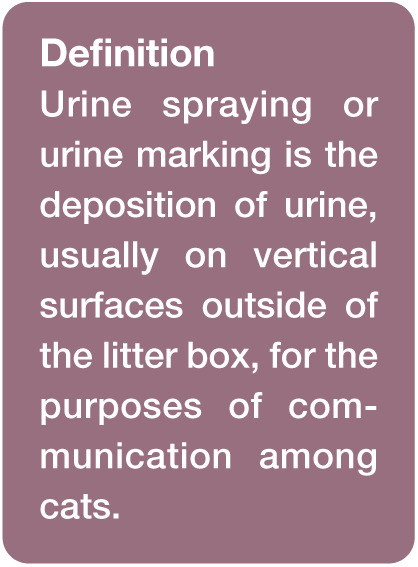
Undesirable indoor elimination (38% in one study) is often the number 1 behavioral reason for relinquishment of cats to shelters, but often the type of objectionable elimination (eg, urination, defecation, urine spraying) is not specified. 7 Casey et al’s 2015 study looked at over 6000 cats relinquished or returned to rescue facilities in the UK over a 1 year period. Of the relinquishments overall, 7% (449 cats) were for behavioral reasons. The data for these 449 cats broke down as follows: 161 (36%) owners reported aggression between cats in the household; 77 (17%) reported house-soiling; 65 (14%) reported aggression towards people; 53 (12%) reported fearful behavior in one or more contexts; 45 (10%) reported problems associated with dogs; 44 (10%) reported one or more other behaviors; and four (1%) reported scratching. Of those cats that were adopted and subsequently returned, the main reason given was behavior (38%) – a far greater proportion than for relinquishments in general. 8
Obtaining medical and behavioral information for urine spraying
Four major areas should be covered when taking a behavioral history for a cat that is urine spraying. First, medical contributions to changes in behavior must be ruled out, remembering that a learned component may exist and the behavior might continue after treatment. Secondly, a complete description of the behavior should be obtained, including what problem behavior is observed, where it occurs, time course, frequency of the behavior and previous treatments. Thirdly, whenever elimination behavior problems are present, gathering litter box information is essential (a home life and environment questionnaire, which includes questions about the litter box, can be found in the article in Part 1 on behavioral awareness in the feline consultation). Finally, if the household has additional animals, especially other cats, the social situation, as well as any environmental or stressful influences, must be explored.
Investigating medical contributions
Initially in a behavioral consultation it is essential to rule out medical disease as either the sole cause of the behavioral change or contributing to the expression of the behavioral complaint. Recommended screening tests include a complete blood count (CBC), biochemistry profile, urinalysis and perhaps other tests and imaging studies as indicated by the history or physical examination.
As with any diagnostic work-up, obtaining pertinent and complete information is essential. Before beginning the behavioral history the clinician should determine if the cat has been gonadectomized. In male cats examination of the penis for penile barbs may often indicate circulating hormone levels; in female cats evidence of estrous behavior may be present. In either case, if the findings are positive, hormonal assays should be performed. Additionally, the practitioner should ask the owner why they believe that this is the cat responsible for depositing the urine marks.
Several studies have looked at the potential contribution of medical problems to the expression of urine spraying in cats. Frank et al assessed 34 urine-spraying cats with a combination of physical examination, CBC, biochemistry profile, urinalysis, urine culture, urine cortisol:creatinine ratios and abdominal radiographs. Thirteen patients (38%) had abnormalities or crystalluria. Seven of them had underlying medical conditions (renal calculi, renal failure, cystic calculi, bacterial urinary infection or cystitis associated with the presence of ammonium biurate crystalluria); the others had crystalluria only. 9
Tynes et al’s case-controlled study evaluated the role of urinary tract disease in gonadectomized urine-spraying cats. 10 The study included 58 gonadectomized cats (47 males and 11 females) with urine-marking behavior (ie, marking on vertical surfaces) and 39 (26 males and 13 females) with no problem urination or urinary tract-associated conditions. Urine was collected by cystocentesis from all cats for urinalysis. Comparison of the data from cats with urine-marking behavior and control cats revealed no differences that could be associated with urine marking. 10 It is likely that many urine-spraying cats have no urinary tract disease.
Cats with endocrine disorders frequently manifest behavioral changes and clinical signs that can be confused with primary behavioral disorders. Hyperthyroidism, for example, is a common feline endocrine disorder that will cause dramatic physical and behavioral changes in cats, including hyperphagia, polydipsia, polyuria and loose stools. 11 Any cat showing behavioral signs such as aggression, reduced interaction with the owner, weight loss or gain, poor grooming habits and house-soiling (which may, in the author’s experience, include urine marking) should be evaluated for a variety of feline endocrine disorders.
Disorders of the adrenal gland may result in altered levels of stress hormones or testosterone, both of which may affect behavior. Increases in testosterone may result in intact male behaviors (eg, urine marking, aggression, mounting) in already neutered animals, and laboratory assessment of blood testosterone levels and ultrasound studies will aid in the diagnosis of these disorders (see ‘Case notes’ on page 211). 10
Obtaining a complete description of the behavior and situation
Clinicians should ask enough questions to clearly understand the situation (see box below). A diagram of where urine spray marks are located is also useful. Urine spraying located by windows and doors may indicate that outdoor cats or other disruptions are triggering the behavior. Often urine spraying is directed at new items brought into the home (eg, shopping bags, strollers or new furniture) that have caused scent disruption in the environment. Since urine spraying is a form of communication, it is often exhibited in prominent locations – a message is best noted in common areas.
Essential to formulating a treatment plan and assessing treatment efficacy is an initial determination of the frequency of urine spraying when a patient is first evaluated. This might be the number of urine marks per day, per week or per month. If the owner is unable to provide this information at the time of the consultation, it can be suggested that they utilize a black light device to identify and count urine marks to get some idea of the frequency and locations. (Note that this is not a definitive method because many other things fluoresce such as other bodily fluids and detergents.) A reduction in the number of urine-spraying marks noted in the home is useful to determine the efficacy of treatment. Assessing the frequency of the behavior is akin to assessing laboratory results; for example, for an elevated white blood count one hopes that treatment will make it decline. The same is true for the frequency of objectionable behaviors and intervention with behavioral therapies.
Figure 1.
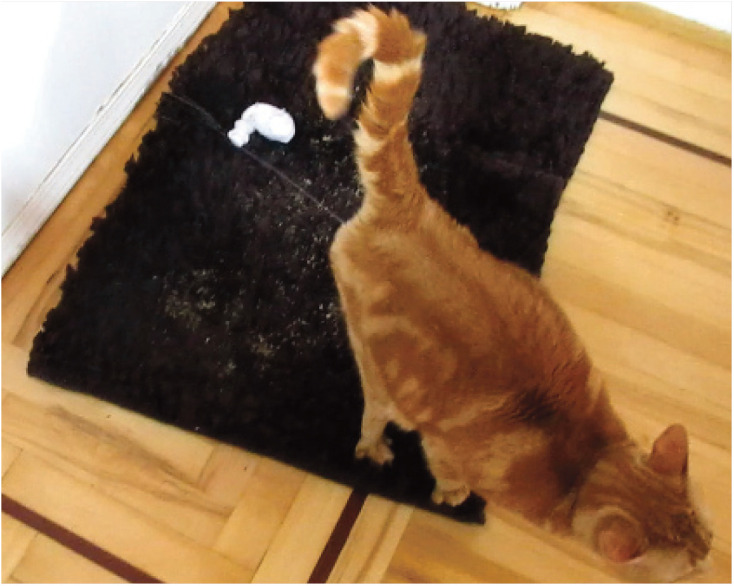
Cats that urine spray are usually standing with their tail upright, and perhaps ‘treading’ their feet. Courtesy of Dr Margie Scherk
Previous treatment strategies employed (eg, behavioral, medication, pheromones) must also be discussed, determining how long each was applied and any perceived results. In some cases previous treatments may have been worthwhile but perhaps not properly applied or not used long enough, or resulted in a decline in urine spraying but not complete cessation.
Gathering litter box information
Since most urine-spraying cats continue to use a litter box to empty the bladder and to defecate, litter box information must be collected.
Typically, this should include:
Number of litter boxes available within the home
Sizes of litter boxes provided
Location of the boxes
Litter material used
Frequency of cleaning – both scooping out waste and total emptying, washing and refilling of the litter boxes.
Discussing the home environment
Finally, a discussion of the home environment should be included, covering cat-to-cat interactions, any changes within the human family, new work hours, and so on (all of which have been correlated with urine spraying2,14). Clinicians should ask about feeding routines and the number of available feeding stations. Daily interactions between the pet in question and the owner/family, as well as other animals within the home, can be explored.
Any changes in the home or household routine – however minor – can be important. Often owners are unaware that a change they instigated and have planned for may be upsetting to their pets when it is put into place. A new job, additional time away from home for various reasons, or the addition of a new family member, are all types of stressors that are associated with changes in behavior. 15 A study by Ramos et al suggests that cats living with other cats are not more stressed, as evidenced by fecal glucocorticoid levels, but that stress may actually be related to other factors including resource availability and the relationship with the owners. 16
Veterinarians may not see all the pets within a household, and so it is important to establish how many other pets there are, especially additional cats. Further information on the social relationship between cats in the household, including any overt signs of aggression (hissing, growling, chasing) and covert signs of aggression (blocking, staring, supplanting from spaces) should be gathered. The management of conflict between household cats is discussed in an accompanying article in this issue on aggression in multi-cat households. Importantly, clinicians should be aware that other cats within the home may also be urine spraying, making it essential that all participants are identified. In some cases agonistic interactions may result in feline house-soiling by other cats and this is important to identify and treat.
Establishing a diagnosis of urine spraying
A diagnosis of urine spraying should be based on the location of the deposited urine and the posture of the cat. Although, as discussed, some cats do mark on horizontal surfaces, this is not the most common location for urine eliminated by a marking cat. In some cases, use of a black light can help owners to visualize urine marks, though this has limitations as already mentioned. A diagnosis of urine spraying must also include the ruling out or treatment of any medical contributions. Moreover, vital to successful treatment is the identification of the suspected triggers (see box below). Once these are known, treatment should include behavioral modification (see article in Part 2 on environmental and behavioural modification) to change the underlying emotional state resulting from these triggers and/or removing them when possible.
Figure 2.
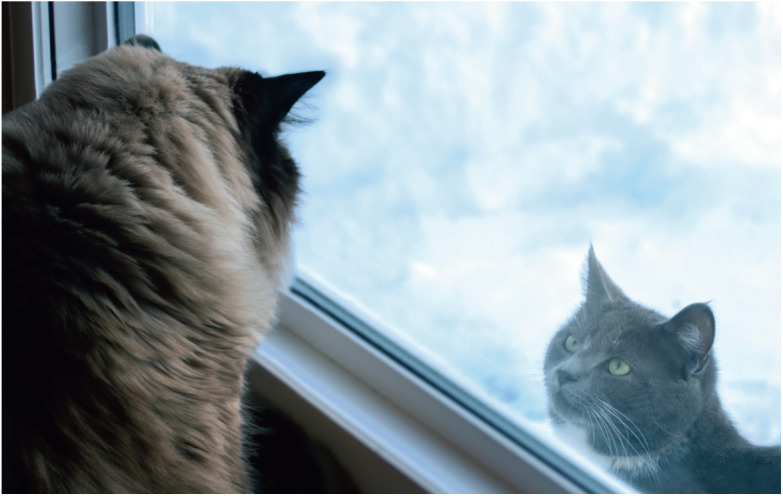
A potential trigger for urine spraying may be the presence of non-resident cats outside the home. Image ©iStock/Greenseas
Treatment of urine spraying
The treatment of urine-spraying behavior includes addressing the underlying causes that have been identified in the diagnosis: neutering intact cats; increasing litter box attractiveness; attempting to resolve the social issues between resident cats; addressing environmental triggers, including controlling the influence of outside/intruder cats; keeping a constant scent profile in the home; creating an enriched environment; scheduling interactive time with the owner that is predictable, positive and consistent; and avoiding change when possible. When there are multiple cats in the home, urine spraying may occur to delineate territory, or due to a lack of adequate resources or space or the stress of too many cats, and these issues must be addressed to aid in resolution. Additional interventions include the use of pheromones, nutraceuticals and psychoactive medications.
Increasing litter box attractiveness and cleaning urine marks
The litter box should be well located and very clean. Pryor et al examined the effects of environmental management for urine-marking cats and found that cleaning the urine marks daily, scooping waste from the litter box daily and changing the litter and cleaning the litter box weekly resulted in up to a 50% decrease in urine-marking behavior. 2 Therefore, waste material should be scooped out once or twice a day, and owners must empty and wash the litter box and replace with entirely fresh litter every 3–4 days for clay litter material and every 1–2 weeks for clumping litter. The depth should be adequate; 3–4 in (~8–10 cm) seems preferred. Research has shown that some cats prefer the clumping materials to clay litter, so switching to a clumping-type product may be beneficial. 14
Litter boxes must be easily accessible, and positioned in quiet locations and where the cats spend their time. Where and how to allocate litter boxes should be decided based on information about the household routine, the number of other cats within the home and the social relationship between individuals. In multi-cat households there should be an adequate number of boxes (one box per cat plus one additional); these need to be in different locations, and not just placed side by side.
Since urine marking is a normal feline behavior, some cats will respond to the creation of an acceptable spraying station. Owners can create an ‘L’-shaped litter arrangement with two litter boxes – one positioned horizontally with litter inside, placed up against another that is empty and orientated vertically (Figure 3a); alternatively, one litter box could be leaned against a wall (Figure 3b). Some cats will use this set-up and limit their urine spraying to this location.
Figure 3.
(a,b) Two examples of how to create spraying stations for cats that persist in urine marking. Initially these litter box set-ups are positioned at the cat’s preferred location, but once use is established they can often be moved to a less conspicuous location or discontinued if treatment is successful. In some cases they may remain indefinitely if the cat will only spray there and nowhere else. Image (b) courtesy of Dr Jacqui Neilson
As well as cleaning of urine spots (see accompanying article on unacceptable indoor elimination), attempts can be made to make the sprayed areas undesirable for future elimination. This might include placing potpourri at the spot and/or food bowls to attempt to change the function of the location either by introducing an unattractive (to cats) smell or encouraging food consumption; alternatively, a urine station can be placed at the location (Figure 3). Although, motion sensors that make loud noises to keep the cat away from the area can be utilized, these can cause fear and anxiety in some cats and are not particularly helpful or kind. Blocking off access to areas where urine spraying occurs (Figure 4) can be a useful environmental modification, but may not be a long-term solution if other inciting stimuli (social conflict with other cats, lack of access to boxes or hiding areas) are not addressed and resolved.
Figure 4.
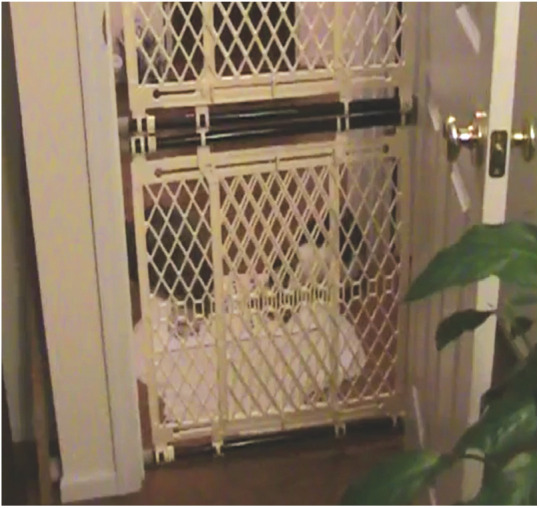
Double baby gates can be used to keep cats in one place and stop them from spraying in a location that will damage household possessions; this method may not be useful long term, however, if other inciting stimuli are not addressed
An effort should be made to minimize scent disruption within the home. This might include leaving strollers and prams outside instead of bringing them indoors, placing gym bags with soiled clothing out of reach, and delaying purchases of new furniture, if possible, until urine spraying is controlled.
Dealing with social issues between cats
Resident cats
Ensuring adequate numbers of important resources such as food bowls, resting places and litter boxes are provided throughout the environment may help to diminish social tension and perhaps spraying behavior (see article in Part 2 on environmental and behavioural modification). Ideally the places with these items should have more than one entry/exit point to keep a cat from being trapped by an aggressor. In situations where the number of cats is causing conflict, it may be difficult to eliminate or decrease spraying behavior without addressing how the cats interact (see accompanying article on aggression in multi-cat households).
In some households it may be necessary for the space to be time shared, allowing cats that do not get along to be separated for some part of the day. Providing separate locations for each cat may allow them to create a sense of ownership without spraying, using facial marking instead. The separate spaces should each have a food bowl, water bowl, litter box and adequate resting and hiding locations. Social interactions with owners must also be consistent and positive. For some cats the provision of spraying stations (Figure 3) may allow the cat to spray in an easily cleaned area. In some cases the household may be divided to limit the interactions between groups of cats (Figure 5).
Figure 5.
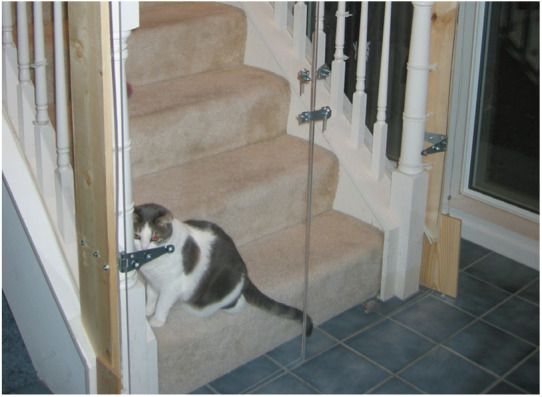
After prolonged therapy the owners of this cat divided the home into two separate zones and the resident cats lived happily without fighting or urine spraying
Outside/intruder cats
Attempts should be made to limit the visibility of outdoor cats to the resident cat(s) 17 and to discourage intrusion by those cats if possible. Blocking visual access from windows and doors, or closing the cat in a room where it cannot see outside cats, are useful measures. Motion sensors or fences and the removal of bird feeders may keep some outdoor cats out of the yard and out of sight.
Introducing positive and predictable social interactions with owners and appropriate environmental changes
An effort should be made by the owner to have predictable, consistent and positive interactions with the cat, including grooming and playtime. Reward-based training may also help to keep cats mentally active and relaxed. Additionally, positive associations can be made during these sessions with new objects brought into the home to help ease the adjustment for the more timid cat. The provision of climbing towers (Figure 6) or shelves can help cats arrange themselves vertically within the space they have. Punishment should always be avoided as it can increase anxiety and create fear of the owner. The cat’s access to previously sprayed areas should be restricted by closing doors or blocking doorways with baby gates or other means (Figure 4).
Figure 6.
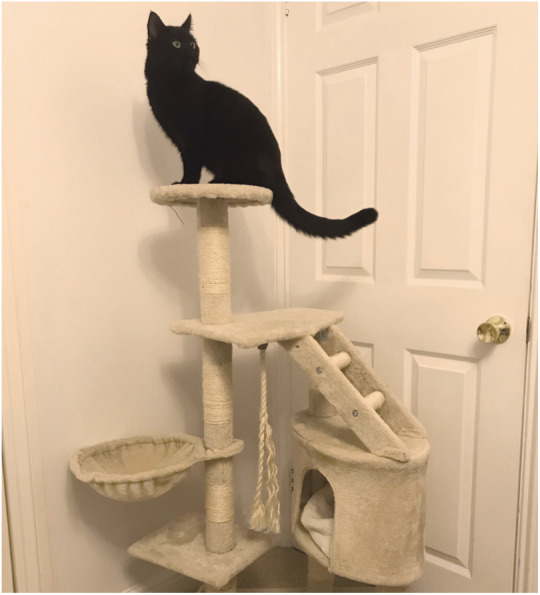
Climbing towers allow cats to arrange themselves vertically, helping to provide a safe location away from, for example, another cat. Courtesy of Cathryn Jordan
Pheromone therapy
A pheromone spray or diffuser (Feliway Classic; Ceva) can also be very useful in the treatment of urine marking. Feliway is a synthetic analogue of the F3 feline facial pheromone and can help to decrease or stop spraying behavior. In a study by Mills and Mills, cats exposed to Feliway in the diffuser form showed a decrease in urine marking when compared with cats treated with placebo. 18 Feliway is often effective in decreasing urine spraying in response to reactional stimuli such as changes in the cat’s environment (moving, new pets, stress, etc). Pheromone therapy has also been used to calm cats in new environments. 19
For cats that are showing agonistic interactions, whether covert or overt, a synthetic analogue of feline appeasing pheromone – Feliway MultiCat (USA) or Feliway Friends (Europe) (Ceva) – may diminish reactivity and promote calmer behaviors. 20
See article in Part 2 on pheromone therapy for further information.
Pharmacological treatments
Drug therapy can be a helpful adjunct to behavioral treatment by decreasing the emotional arousal that may motivate urine spraying (see ‘Case notes’ below). When considering drug therapy, a complete behavioral and medical history should be obtained prior to choosing a medication. Drugs used for problem behaviors are not approved for use in cats, except for clomipramine, which is licensed in Australia for cats that are urine spraying; 21 therefore, in the majority of cases treatment involves extra-label drug usage. Complete serum biochemistry and possibly cardiac work-ups are indicated prior to use. Owners need to be informed of potential side effects and extra-label use, and consent and release forms should be obtained. Frequent client contact to assess efficacy and any side effects of drug therapy is necessary. Owners should be encouraged to be at home for the first few doses to observe for any effect or side effects.
Drug therapy should be instituted only when a behavioral diagnosis has been made. Drug therapy alone is rarely curative and is best used in conjunction with behavior therapy. Cats with behaviors caused by stress, territorial stimuli or anxiety are more likely to show some response to medication. Elimination outside of the litter box due to litter or location aversions or litter cleanliness problems is rarely improved by drug therapy alone.
Currently the commonly used drugs are selective serotonin reuptake inhibitors and tricyclic antidepressants (see article in Part 2 on psychoactive medications). Other agents have been used in the past, including buspirone, 12 benzodiazepines 22 and progestin, 22 and are not discussed in this article.
Fluoxetine
In a double-blind placebo-controlled clinical trial, Pryor et al tested the effectiveness of fluoxetine hydrochloride for the treatment of urine marking. 23 In the drug treatment phase each cat received either drug (1.0 mg/kg q24h) or placebo for 8 weeks and owners recorded the urine marks observed. Each household followed an environmental plan, used the same cleaner to remove urine marks, had one more litter box than the number of cats in the home, and scooped the box daily and changed the litter and washed the box weekly. Cats on the medication showed a significant decrease in urine marking when compared with placebo by weeks 7 and 8. A correlation was found between marking at baseline and return to marking after the drug was withdrawn (ie, cats that marked more frequently were more likely to resume marking).
Fluoxetine can take 2–4 weeks to produce an effect on behavior. The most common side effects are gastrointestinal, such as anorexia, nausea and diarrhea, but may also include sedation, irritability and anxiety. 24
Clomipramine
Clomipramine has also been shown to be efficacious in the control of urine spraying in cats. The drug is a tricyclic antidepressant with both serotonin reuptake blocking and some norepinephrine reuptake blocking effect. A change in behavior may not be noted for 2–4 weeks after initiation of therapy. Common side effects include urinary retention, tachycardia, depression and inappetence. 24
In a study by Landsberg and Wilson, 25 urine-spraying cats were treated with clomipramine at 0.54 mg/kg PO q24h without any behavior modification applied. 25
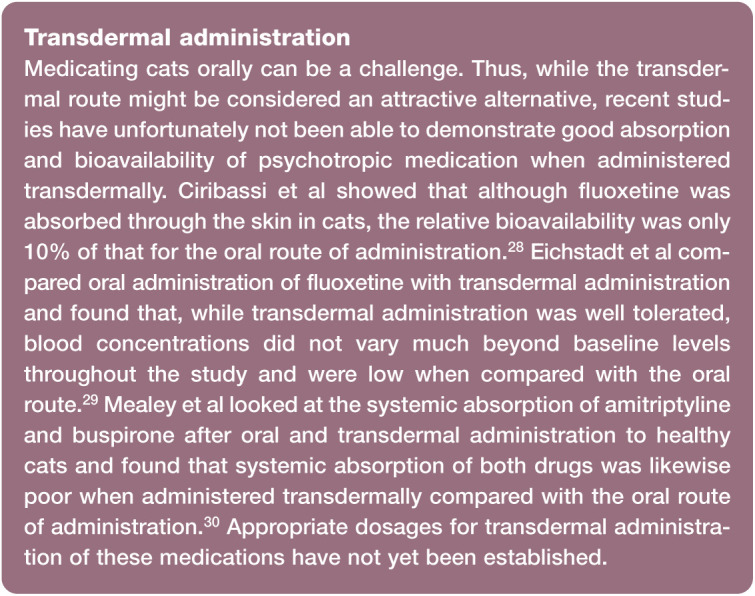
A statistically significant reduction in urine spraying was recorded, with 20/25 cats showing a ≥75% reduction in spraying within 4 weeks. 25 Overall the side effects noted were mild and included sedation, and decreased appetite and urination. Another randomized controlled multi-center trial found that, when compared with a placebo, clomipramine significantly reduced the frequency of urine spraying in cats. 26 In this study behavioral and environmental modification was implemented for all cats in addition to medication. The recommended initial dose was 0.25–0.5 mg/kg PO q24h. 26
Fluoxetine vs clomipramine
An additional study compared the use of fluoxetine and clomipramine in urine-spraying cats. As well as examining for differences between the two drugs in reducing urine-spraying behavior, the investigators also looked at: whether increasing the length of treatment (>8 weeks) reduced the occurrence of urine spraying; if there was recurrence of urine spraying after abrupt withdrawal of the medication; and whether cats successfully treated with either medication that resumed marking after drug withdrawal could be treated successfully again with the same drug regimen. 27 Although the study was small, the data revealed that the efficacy of fluoxetine and clomipramine was similar. Fluoxetine showed increased efficacy in reducing urine marking when administered for longer than 8 weeks; however, some cats needed to be treated for 32 weeks to reach a ≥90% reduction in urine marking. When fluoxetine was abruptly withdrawn, most cats reverted to urine-marking behaviors; however, those that responded to the first treatment regimen responded again to reinstatement of the medication. 27
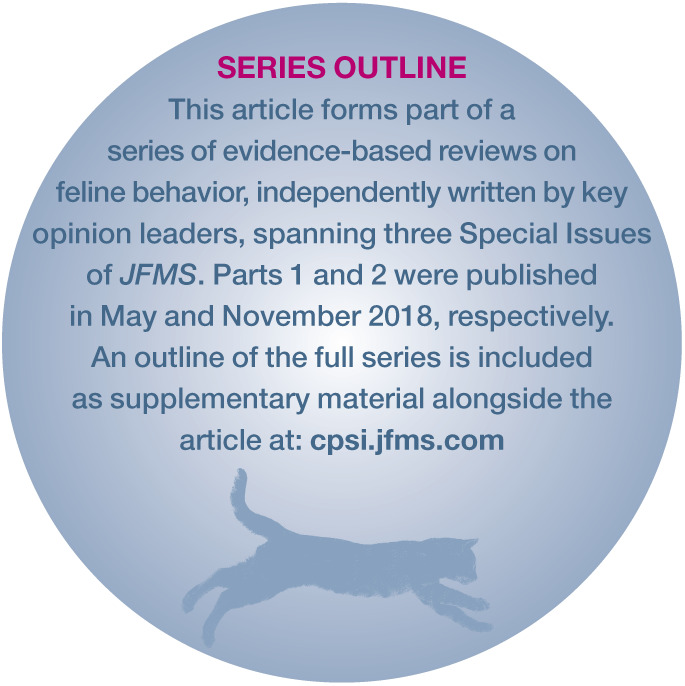
Prognosis
Marking behaviors have a variable response to treatment. Factors such as outside/intruder cats and the ability to control them, household social conflicts with other cats and ongoing household changes may all affect the potential for resolution of the spraying behavior. 18 Ogata and Takeuchi found that while urine marking decreased with pheromone therapy, urine marking was sustained at a higher level in households with intercat aggression. 31 Mills and White found that while urine marking decreased with pheromone therapy, it often was not eradicated. 32 However, the reduction in spraying behavior was acceptable to the clients as an outcome. Marking behavior may persist or recur after medication is stopped. As discussed above, long-term usage of medication may be necessary to inhibit urine marking. 27
In some cases, despite intensive efforts at both pharmacological and behavioral therapy, urine spraying may remain at levels unacceptable to the owners. When this occurs, most often in a multi-cat home, rehoming is an option that may be suitable and improve pet welfare. In a calmer, less stressful environment urine spraying may diminish or even stop, allowing the cat to remain in a new loving home.
Key Points
Urine spraying is a common and normal but objectionable feline behavior.
Diagnosis is based on the location of the urine (usually vertical) and certain known triggers (estrous females, intercat aggression, outside/intruder cats or social/environmental changes).
Treatment focuses on decreasing the need to mark by removing the triggers, keeping litter boxes clean and plentiful, maintaining a consistent scent profile within the home and using pheromones and medication where needed.
Supplemental Material
Special issues on feline behaviour and problem behaviours
Acknowledgments
The title image of the spraying cat on page 209 is provided courtesy of Hazel Carney.
Footnotes
The author declared no potential conflicts of interest with respect to the research, authorship, and/or publication of this article.
Funding: The author received no financial support for the research, authorship, and/or publication of this article.
References
- 1. Natoli E. Behavioural responses of urban feral cats to different types of urine marks. Behaviour 1985; 94: 234-243. [Google Scholar]
- 2. Pryor PA, Hart BL, Bain MJ, et al. Causes of urine marking in cats and effects of environmental management on frequency of marking. J Am Vet Med Assoc 2001; 219: 1709-1713. [DOI] [PubMed] [Google Scholar]
- 3. Hart BL, Cooper L. Factors relating to urine spraying and fighting in prepubertally gonadectomized cats. J Am Vet Med Assoc 1984; 184: 1255-1258. [PubMed] [Google Scholar]
- 4. Howe LM, Slater MR, Boothe HW, et al. Long-term outcome of gonadectomy performed at an early age or traditional age in cats. J Am Vet Med Assoc 2000; 217: 1661-1665. [DOI] [PubMed] [Google Scholar]
- 5. Porters N, de Rooster H, Verschueren K, et al. Development of behavior in adopted shelter kittens after gonadectomy performed at an early age or at a traditional age. J Vet Behav 2014; 9: 196-206. [Google Scholar]
- 6. Bamberger M, Houpt KA. Signalment factors, comorbidity, and trends in behavior diagnoses in cats: 736 cases (1991–2001). J Am Vet Med Assoc 2006; 229: 1602-1606. [DOI] [PubMed] [Google Scholar]
- 7. Salman MD, Hutchison J, Ruch-Gallie R, et al. Behavioral reasons for relinquishment of dogs and cats to 12 shelters. J Appl Anim Welf Sci 2000; 3: 93-106. [Google Scholar]
- 8. Casey RA, Vandenbussche S, Bradshaw JWS, et al. Reasons for relinquishment and return of domestic cats (Felis silvestris catus) to rescue shelters in the UK. Anthrozoos 2015; 4: 347-358. [Google Scholar]
- 9. Frank DF, Erb HN, Houpt KA. Urine spraying in cats: presence of concurrent disease and effects of a pheromone treatment. Appl Anim Behav Sci 1999; 61: 263-272. [Google Scholar]
- 10. Tynes VV, Hart BL, Pryor PA, et al. Evaluation of the role of lower urinary tract disease in cats with urine-marking behavior. J Am Vet Med Assoc 2003; 223: 457-461. [DOI] [PubMed] [Google Scholar]
- 11. Gunn-Moore D. Feline endocrinopathies. Vet Clin North Am Small Anim Pract 2005; 35: 171-210. [DOI] [PubMed] [Google Scholar]
- 12. Hart BL, Eckstein RA, Powell KL, et al. Effectiveness of buspirone on urine spraying and inappropriate urination in cats. J Am Vet Med Assoc 1993; 203: 254-258. [PubMed] [Google Scholar]
- 13. Marder AR, Engel JM. Long-term outcome after treatment for feline inappropriate elimination. J Appl Anim Welf Sci 2002; 5: 299-308. [DOI] [PubMed] [Google Scholar]
- 14. Horwitz DF. Behavioral and environmental factors associated with elimination behaviour problems in cats: a retrospective study. Appl Anim Behav Sci 1997; 52: 129-137. [Google Scholar]
- 15. Stella JL, Lord LK, Buffington CT. Sickness behaviors in response to unusual external events in healthy cats and cats with feline interstitial cystitis. J Am Vet Med Assoc 2011; 238: 67-73. [DOI] [PMC free article] [PubMed] [Google Scholar]
- 16. Ramos D, Reche-Junior A, Fragoso PL, et al. Are cats (Felis catus) from multi-cat households more stressed? Evidence from assessment of fecal glucocorticoid metabolite analysis. Physiol Behav 2013; 122: 72-75. [DOI] [PubMed] [Google Scholar]
- 17. Cooper LL. Feline inappropriate elimination. Vet Clin North Am Small Anim Pract 1997; 27: 569-600. [DOI] [PubMed] [Google Scholar]
- 18. Mills DS, Mills CB. Evaluation of a novel method for delivering a synthetic analogue of feline facial pheromone to control urine spraying by cats. Vet Rec 2001; 149: 197-199. [DOI] [PubMed] [Google Scholar]
- 19. Griffith CA, Steigerwald ES, Buffington CA. Effects of a synthetic facial pheromone on behavior of cats. J Am Vet Med Assoc 2000; 217: 1154-1156. [DOI] [PubMed] [Google Scholar]
- 20. DePorter TL, Bledsoe DL, Beck A, et al. Evaluation of the efficacy of an appeasing pheromone diffuser product vs placebo for management of feline aggression in multi-cat households. A pilot study. J Feline Med Surg. Epub ahead of print 1 May 2018. DOI: 10.1177/1098612X18774437. [DOI] [PMC free article] [PubMed] [Google Scholar]
- 21. Denenberg S, Bram Dube M. Tools for managing feline problem behaviours: psychoactive medications. J Feline Med Surg 2018; 20: 1034-1045. [DOI] [PMC free article] [PubMed] [Google Scholar]
- 22. Cooper LL, Hart BL. Comparison of diazepam with progestin for effectiveness in suppression of urine spraying behavior in cats. J Am Vet Med Assoc 1992; 200: 797-801. [PubMed] [Google Scholar]
- 23. Pryor PA, Hart BL, Cliff KD, et al. Effects of a selective serotonin reuptake inhibitor on urine spraying behavior in cats J Am Vet Med Assoc 2001; 219: 1557-1561. [DOI] [PubMed] [Google Scholar]
- 24. Mills DS, Simpson BS. Psychotropic agents. In: Horwitz D, Mills DS, Heath S. (eds). BSAVA manual of canine and feline behavioral medicine. Gloucester, UK: BSAVA, 2002, pp 237-248. [Google Scholar]
- 25. Landsberg GM, Wilson AL. Effects of clomipramine on cats presented for urine marking. J Am Anim Hosp Assoc 2005; 41: 3-11. [DOI] [PubMed] [Google Scholar]
- 26. King JN, Steffan J, Heath SE, et al. Determination of the dosage of clomipramine for the treatment of urine spraying in cats. J Am Vet Med Assoc 2004; 225: 881-887. [DOI] [PubMed] [Google Scholar]
- 27. Hart BL, Cliff KD, Tyne VV, et al. Control of urine marking by use of long-term treatment with fluoxetine or clomipramine in cats. J Am Vet Med Assoc 2005; 226: 378-382. [DOI] [PubMed] [Google Scholar]
- 28. Ciribassi J, Luescher A, Pasloske KS, et al. Comparative bioavailability of fluoxetine after transdermal and oral administration to healthy cats. Am J Vet Res 2003; 64: 994-998. [DOI] [PubMed] [Google Scholar]
- 29. Eichstadt LR, Corriveau LA, Moore GE, et al. Absorption of transdermal fluoxetine compounded in a lipoderm base compared to oral fluoxetine in client-owned cats. Int J Pharm Compd 2017; 21: 242-246. [PubMed] [Google Scholar]
- 30. Mealey KL, Peck KE, Bennett BS, et al. Systemic absorption of amitriptyline and buspirone after oral and transdermal administration to healthy cats. J Vet Intern Med 2004; 18: 43-46. [DOI] [PubMed] [Google Scholar]
- 31. Ogata N, Takeuchi Y. Clinical trial of a feline pheromone analogue for feline urine marking. J Vet Med Sci 2001; 63: 157-161. [DOI] [PubMed] [Google Scholar]
- 32. Mills DS, White JC. Long-term follow up of the effect of a pheromone therapy on feline spraying behavior. Vet Rec 2000; 7: 746-747. [PubMed] [Google Scholar]
Associated Data
This section collects any data citations, data availability statements, or supplementary materials included in this article.
Supplementary Materials
Special issues on feline behaviour and problem behaviours





